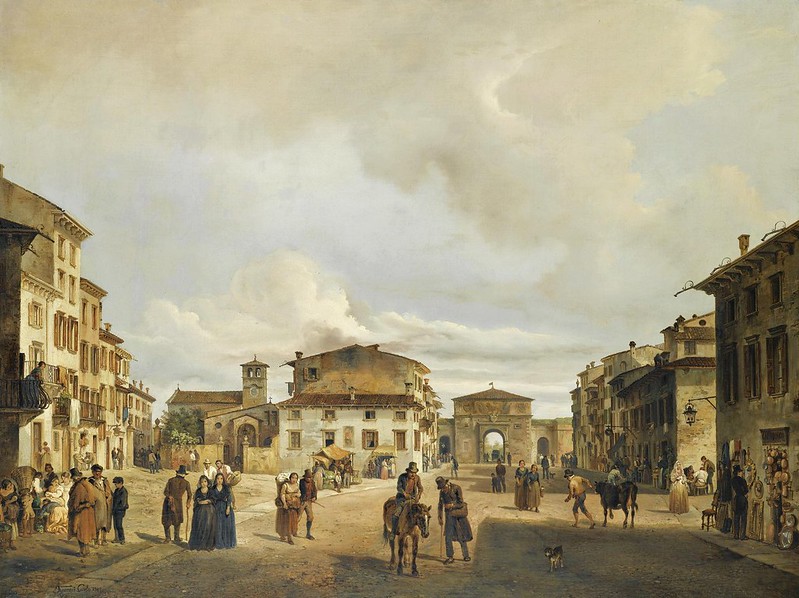Jean-François Dandrieu (1682-1738)
- Les Caractères de la Guerre (1718)
Performers: Angelicum Orchestra of Milan; Newel Jenkins (1915-1996, conductor)
Further info: Battle Music
---
Composer and organist, nephew of Pierre Dandrieu (1664-1733). After
Couperin and Rameau, he was the most celebrated harpsichord composer of
the 18th century. His parents, both from Angers, were Jean d'Andrieu, a
prominent and very comfortably-off master gainier, and Françoise
Rondeau. No record of his birth exists; the death certificate gives his
age as 56, and a document of 10 September 1697 gives it as 15. He had a
brother, Nicolas, and two sisters, Jeanne-Françoise Dandrieu
(1695-c.1755) and Marie Louise-Charlotte Dandrieu. According to Titon du
Tillet he was a pupil of J.-B. Moreau, a native of Angers. It was
probably owing to Moreau that the child Dandrieu, not yet five years
old, played before Elisabeth-Charlotte of Bavaria, the princess
Palatine, wife of the king's brother, Philippe d'Orléans. The connection
appears to have continued, since nine years later he was to dedicate a
book of sonatas to that same delightful lady. Through her, he might also
have played to Marie-Anne-Christine-Victoire of Bavaria, wife of the
dauphin and, like Elisabeth-Charlotte, a Wittelsbach. In any case, a
German connection seems to have been established, which manifested
itself in the existence of a considerable number of pieces scattered
through nine German and Austrian sources, both printed and manuscript,
as well as in a style that was evidently perceived as sufficiently
German for him to have been commonly called ‘the German organist’ (F.W.
Marpurg, Historisch-kritische Beyträge zur Aufnahme der Musik (Berlin,
1754-58). His first official position was as organist of St Merry, a
prestigious post occupied by Lebègue until his death in 1702. Dandrieu
assumed the duties in January 1704, was named to the post on 20 July
1705 and remained there until his death. The title-page of Livre de
Sonates op.2 (1710) names him organist of St Barthélemy; no document
explains why he should have temporarily occupied his uncle's post, to
which he succeeded officially only upon the latter's death in 1733.
On 17 December 1721 he was confirmed as organist of the royal chapel for
the April to July quarter succeeding J.-B. Buterne, a post with heavy
duties that would have obliged him to provide a substitute (perhaps his
sister) at St Merry and later St Barthélemy. The most striking witness
to Dandrieu's talent is his two sets of string sonatas (1705 and 1710),
which show an astounding mastery of imitative counterpoint and tonally
directed harmony, italiante rhythm and disjunct melody. Rarest of all
for a French composer, however, was his ability to achieve continuity
and drive by delaying or avoiding cadences or maintaining the rhythmic
flow through them. La Laurencie (who misdated the 1710 book to after
1733) characterized the melodic style of his allegros as ‘vive, légère,
d'une extrême élégance’. Whether taught by Moreau or instilled by study
of Corelli and the example, perhaps, of Mascitti (attached to the
Orléans establishment from 1704), these skills, counterpoint above all,
permeated his music to the end. To a greater extent than any of his
French contemporaries, Dandrieu seems to have thought polyphonically. It
was natural for him to invent melodies that worked in double
counterpoint, to imitate them immediately in another voice and to
transpose, recombine them and develop them. Sequences, falling or
rising, often with exchange of parts and chains of suspensions, and
single, transposed repetitions of longer phrases were his favourite way
of spinning out ideas. Dandrieu wrote one piece for orchestra, Les
caractères de la guerre (1718), to be danced in an unidentified opera.
Like so many others of his pieces, it too reappeared again and again,
first in the harpsichord book of 1724, then in revised and separately
issued re-editions. His Principes de l'accompagnement was no less
successful, and its approach was apparently considered useful enough to
merit a thorough updating according to Rameau's advances by an unknown
hand as late as 1777; only the announcement survives.

















